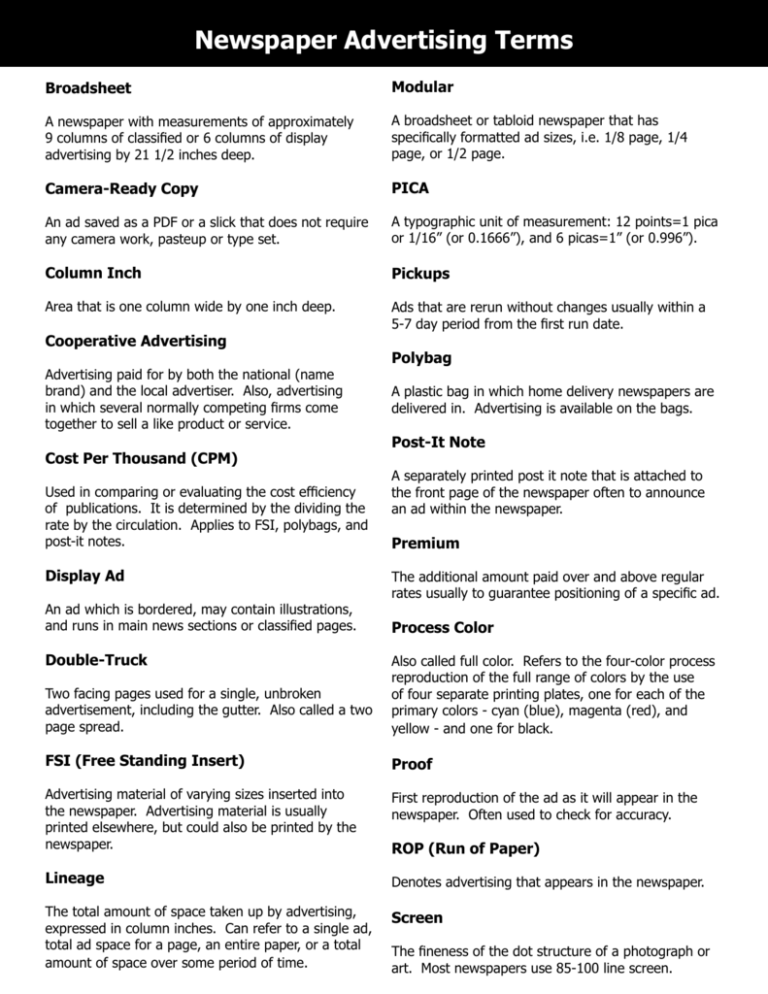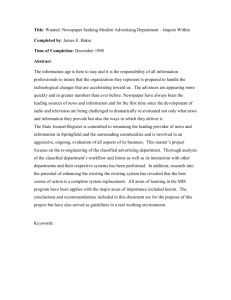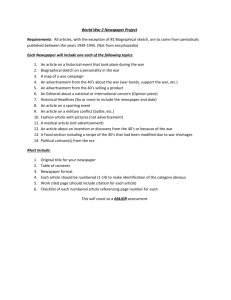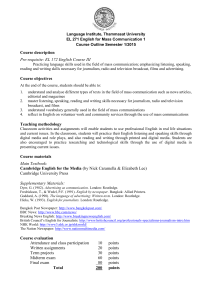Newspaper Advertising Terms
advertisement

Newspaper Advertising Terms Broadsheet Modular A newspaper with measurements of approximately 9 columns of classified or 6 columns of display advertising by 21 1/2 inches deep. A broadsheet or tabloid newspaper that has specifically formatted ad sizes, i.e. 1/8 page, 1/4 page, or 1/2 page. Camera-Ready Copy PICA An ad saved as a PDF or a slick that does not require any camera work, pasteup or type set. A typographic unit of measurement: 12 points=1 pica or 1/16” (or 0.1666”), and 6 picas=1” (or 0.996”). Column Inch Pickups Area that is one column wide by one inch deep. Ads that are rerun without changes usually within a 5-7 day period from the first run date. Cooperative Advertising Advertising paid for by both the national (name brand) and the local advertiser. Also, advertising in which several normally competing firms come together to sell a like product or service. Cost Per Thousand (CPM) Used in comparing or evaluating the cost efficiency of publications. It is determined by the dividing the rate by the circulation. Applies to FSI, polybags, and post-it notes. Display Ad An ad which is bordered, may contain illustrations, and runs in main news sections or classified pages. Double-Truck Polybag A plastic bag in which home delivery newspapers are delivered in. Advertising is available on the bags. Post-It Note A separately printed post it note that is attached to the front page of the newspaper often to announce an ad within the newspaper. Premium The additional amount paid over and above regular rates usually to guarantee positioning of a specific ad. Process Color Two facing pages used for a single, unbroken advertisement, including the gutter. Also called a two page spread. Also called full color. Refers to the four-color process reproduction of the full range of colors by the use of four separate printing plates, one for each of the primary colors - cyan (blue), magenta (red), and yellow - and one for black. FSI (Free Standing Insert) Proof Advertising material of varying sizes inserted into the newspaper. Advertising material is usually printed elsewhere, but could also be printed by the newspaper. First reproduction of the ad as it will appear in the newspaper. Often used to check for accuracy. Lineage Denotes advertising that appears in the newspaper. The total amount of space taken up by advertising, expressed in column inches. Can refer to a single ad, total ad space for a page, an entire paper, or a total amount of space over some period of time. Screen ROP (Run of Paper) The fineness of the dot structure of a photograph or art. Most newspapers use 85-100 line screen. Spadea Tabloid Broadsheet sized wrap within a newspaper that wraps around the spine of the comic section. A newspaper that is more than 10” wide and at least 11” deep. Usually a 5 column by 13” page size. Spec Ad Tearsheet A preliminary layout showing the position of illustrations and text of a proposed ad. A full page torn from a newspaper given to an advertiser to show proof of publication. Spot Color Color which only reproduces itself and does not blend with another color to create new colors. Online Advertising Terms Above the Fold Impression Any part of the website that can be seen without the user having to scroll down the page. The unit of measurement for every time an advertisement is delivered or seen by a visitor to a web page. Clicks Measures the response of a user to an online advertisement. A click is when a user clicks on an ad and is taken to the advertiser’s web page. CTR (Click Through Rate) Measures the success of an online campaign. It is calculated as a percentage of the impressions that resulted in a click. Inventory Total number of ad views or impressions that a web site has to sell over a given period of time (usually figured by month). Screenshot An image taken by the computer to record the visible items displayed on the monitor. Contextual Advertising SOV (Share of Voice) The advertisement is relevant to the content on the web page. Refers to the relative portion of exposure of an advertisement within a defined position over a period of time. CPM (Cost Per Thousand) Industry standard for selling ads on web sites. Advertisers pay for every thousand impressions of their advertisement. Demographics Data about the size and characteristics of an audience. Unique Visitor The number of individual visitors to a web site over a defined period of time. Each unique visitor is counted only once in that period of time, no matter how many times they visit the web page.







